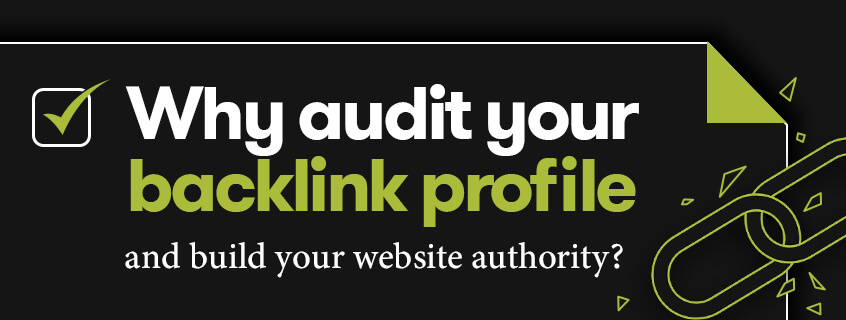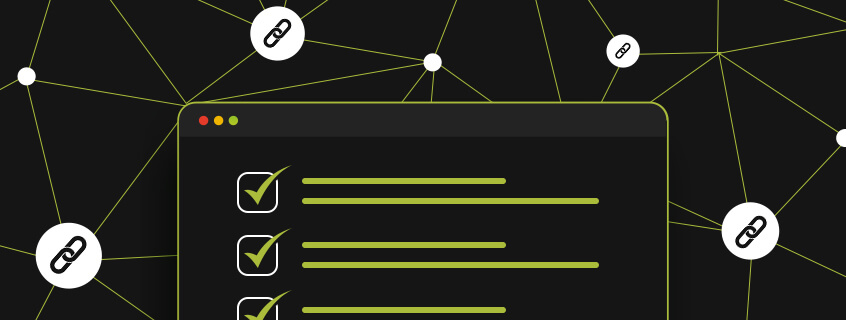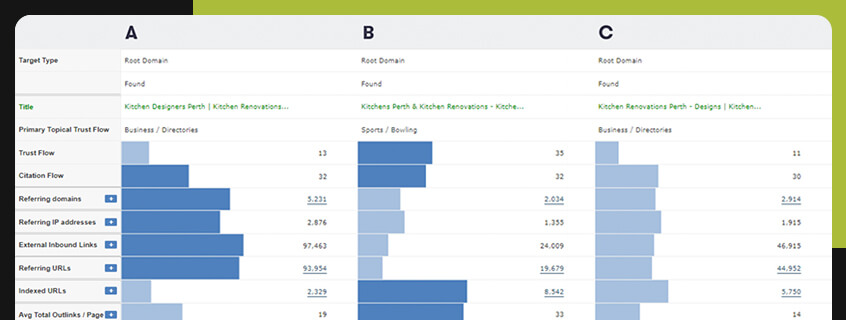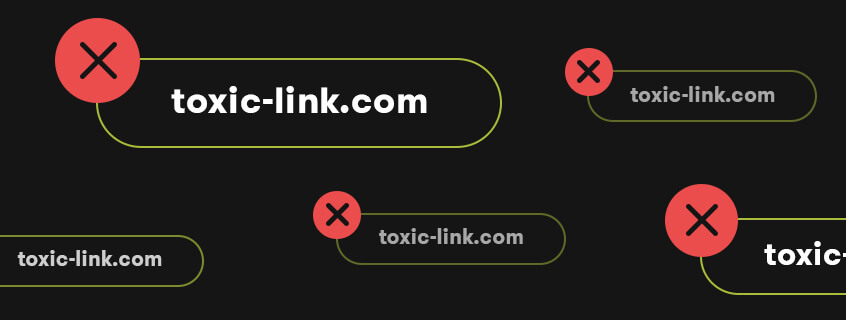
Why audit your backlink profile and build your website authority?

A backlink audit is the best way to discover the quality and quantity of links pointing to your website. Bad backlinks can have crushing consequences for your rankings. But high-quality backlinks can power you to the top spot.
If you’ve followed on-page SEO best practices and still aren’t ranking on Google, it’s time to check on your backlinks. If you’re struggling to outrank your competitors, a robust backlink strategy could give you the extra oomph you need. To help you get the most out of your off-page SEO, here’s our guide to doing a backlink audit on your site.
What are backlinks in SEO?
Backlinks are links from other websites that point to your website. They’re also sometimes called inbound links or incoming links. Backlinks are one of the key components of off-page SEO. That is SEO strategies that take place off your website, as opposed to on-page SEO which happens on your web pages.
Backlinks act like votes. Google counts the votes to determine how much authority your website has. Websites with higher authority and quality backlinks rank higher in the search results.
Authority building through quality backlinks has a tangible impact on your rankings. In fact, in many industries, it’s the difference between ranking in position 5 or position 1. In other words, if you want to succeed with SEO, backlinks matter. Big time.
What’s a quality backlink?
A quality backlink is a naturally placed link that comes from a high domain authority website. That is a website that’s trusted by users as well as Google. To be good quality, a backlink needs to be contextually relevant. In other words, the link should be relevant to your industry, product, or service.
What’s a harmful backlink?
Not all backlinks are equal. Some backlinks are downright harmful to your website’s authority and rankings. That’s why you can’t just be collecting backlinks willy-nilly to beef up your numbers. Google’s algorithm is better than ever at sniffing out irrelevant and toxic backlinks. We’re talking links from spammy websites, paid link schemes, and links from completely unrelated sites. Black hat tactics like these aren’t worth their salt. Use them and you’ll find yourself in Google’s bad books, struggling to rank at all.
What’s a backlink audit – and why should you do one for your site?
A backlink audit is the best way to understand what’s going on with your site’s backlink profile. By doing a backlink audit, you’ll get to:
- See how your backlink profile compares to your competitors
- Get rid of harmful or unhelpful backlinks
- Clean up broken and wasted links
- Find opportunities for new quality backlinks
Once you’ve done a backlink audit, you can figure out how you’re going to improve your backlinks and build your site’s authority moving forward.
Many businesses put all their eggs into on-page SEO strategies. And while on-page SEO is important, it’s only half the story. By also investing in the off-page health of your site, you can get ahead of your competitors and impress Google. If you want to rank higher in the search results, you can’t overlook your backlink strategy.
How to do a backlink audit
At Dilate, we help businesses big and small implement successful SEO strategies. And quality backlink building is a crucial part of our process. Here’s our step-by-step guide on how to do a backlink audit for your website.
Step 1. Get a comprehensive list of all your backlinks

Firstly, you need to get a full overview of all the links that are pointing to your website. You can do this for free in Google’s Search Console tool. Simply open your Dashboard and click Search Traffic > Links to Your Website.
If you don’t have a lot of backlinks, you can go through each of your links individually. This is the most thorough way to check on the health of your backlinks. But if you have a lot of links, it’s not time-effective. To analyse your links in bulk, you can use a backlink analysis tool.
Whatever tool you use, make sure you’re looking at factors like:
- Which websites link to yours the most?
- What’s your most linked content?
- What anchor texts are used – and are they natural?
- How many unique linking domains do you have? (Links from the same domain carry less weight, so have a diverse range of link sources is usually good)
- What’s your dofollow vs no follow ratio?
- Has your link profile been growing over time? (Look for spikes in growth which may be caused by content or campaigns that performed really well)
- Where are your linking domains located? (Diversity is good, but you generally want backlinks from relevant regions and geographic locations. For example, if you’re a business in Perth, but all your links are coming from the UK, you might need to work on more local links.)
- What pages are being linked to? (If all your backlinks are pointing to your homepage, consider campaigns to attract links for your internal pages.)
Step 2. Compare your backlink profile to your competitors

To give your site the most accurate evaluation, it’s important to do so in context. Check out your competitors’ backlink profiles using a backlink checker tool. This will help you identify where yours might be lacking. And where you’re doing well. Compare the factors listed in Step 1 to see how your profile stacks up.
Step 3. Check for contextuality and relevance
High quality backlinks are always contextual and relevant. If you’ve got links that are irrelevant to your business, they’re putting your rankings at risk. Even if you’re not experiencing a decline in traffic now, you could be in the near future.
Let’s go deeper with an example. The screenshot below compares the backlink profile of three competitors in the same “kitchen renovations/designers” space.

Take a look at the trust flow and citation flow categories. Trust flow tells us the quality of links, while citation flow tells us the amount of links. Typically, these two numbers are performing “well” when they’re high and very close to each other.
Just looking at trust flow and citation flow, who would you pick as having the best profile? B looks like the winner right? After all, they’ve got 32 for citation flow and 35 for trust flow. Well… not so fast.
The true winner is actually A. Notice the category that B is building links in. They are a “kitchen renovation” company but they’re building links in “sports/bowling”. This is the exact opposite of being contextually relevant. Sports and bowling have no relevant mesh with kitchen renovations.
In this example, A is the clear winner, trumping both other profiles. Of course, their trust flow could be better. But this can be improved by building more good and relevant links over time. A is set up for long term success.
B might have great stats at the moment. But with the way Google is going, context and relevance is everything. Your backlink strategy must be long-term focused and meeting Google’s guidelines. Afterall, what’s stopping Google from tightening their relevance belt overnight? Where would this leave B? With a whole lot of harmful links that need disavowing. This would then drastically drop their trust and citation flow figures too.
That being said, it’s not impossible for B to work back into a healthy place again. It’ll just take a thorough backlink audit and long-term strategy to win more quality backlinks.
Step 4. Fix broken links

Sometimes you might have backlinks pointing to a 404 error page. This can happen if your page has been deleted or redirected. Sometimes it might be a linking error by the linking website. Broken backlinks like these mean your site is missing out on benefits that the inbound links could offer. Use a backlink tool to locate broken links.
Then fix your broken links by:
- Reaching out the the linking website and asking them to fix the link
- Redirecting the broken page
- Creating new content for the broken page
Step 5. Check if you have link penalties

If Google detects some foul play when it comes to link building on your site, you could receive a link penalty. Link penalties can have huge impacts on your rankings, and your website traffic. It’s possible to recover from link penalties, but you should deal with them as quickly as possible.
There are two types of link penalties:
- Manual penalties – handed out manually by the Google team if they spot something wrong with your backlink profile.
- Automatic penalties – automatically applied to links that go against the Google guidelines.
You’ll receive a message from Google Webmasters if you get a manual penalty. To check if you have a manual penalty, go to your Google Search Console, and click on Security & Manual Actions > Manual Actions.
Automatic penalties can be harder to discover. The clearest warning sign is a big drop in your organic website traffic. Of course, there could be natural reasons for a drop in rankings. But, if you notice a big loss of traffic on a particular web page, you should investigate further for bad links.
Step 6. Remove or disavow toxic links

You don’t want to keep toxic links hanging around. Whether or not you’ve got a Google penalty, it’s important to get rid of harmful links so they don’t negatively impact your site.
Toxic links come in many forms. In your backlink audit, look out for these types of links:
- Coming from spam sites
- Coming from sites that only exist for backlinking
- Hidden in footers
- Unnaturally included in comments
- Coming from sites that are irrelevant to your business
- Clearly marked as sponsored
There are two ways to get rid of toxic backlinks:
- If you have the appropriate contact details, you can ask the website with the link to remove it.
- Disavow the link using Google’s Disavow Tool. This essentially means asking Google to ignore the link and not take it into account for your site’s ranking.
Step 7. Build new quality links

A backlink audit is awesome. But it shouldn’t be the end of the road. You’ve finished all the hard work of analysing your current backlink profile, and cleaning up harmful links. Now it’s time to look forward to the future. How are you going to improve your backlink profile?
Depending on your goals, your backlink strategy might include things like:
- Writing and submitting high quality guest posts to relevant sites
- Creating share-worthy infographics
- Marketing your content on social media so more people can find it
- Giving interviews or offer expert opinions on relevant websites
- Mining your competitors’ best backlinks for similar opportunities
Need help nailing your backlink strategy?
Building authority through high quality backlinks sounds like a fairly simple game plan. But actually implementing it to achieve good results can be tricky. Like the rest of your SEO strategy, you need to constantly monitor, manage and optimise your backlink profile.
If you pay no attention to your backlinks, you run the risk of losing rankings and conversions. On the other hand, conducting regular backlink audits will help you improve your visibility on Google and stay ahead of your competition.
If you’re new to SEO or simply don’t have the time to do your own backlink audit, consider getting expert help. Call the Dilate team on to see what’s possible.
Subscribe to our Newsletter
RELATED BLOG

Generative Engine Optimisation (GEO): what is it, and how can you bake it into your marketing?

Mentor Marketing joins Dilate.

Generative Engine Optimisation (GEO): what is it, and how can you bake it into your marketing?














